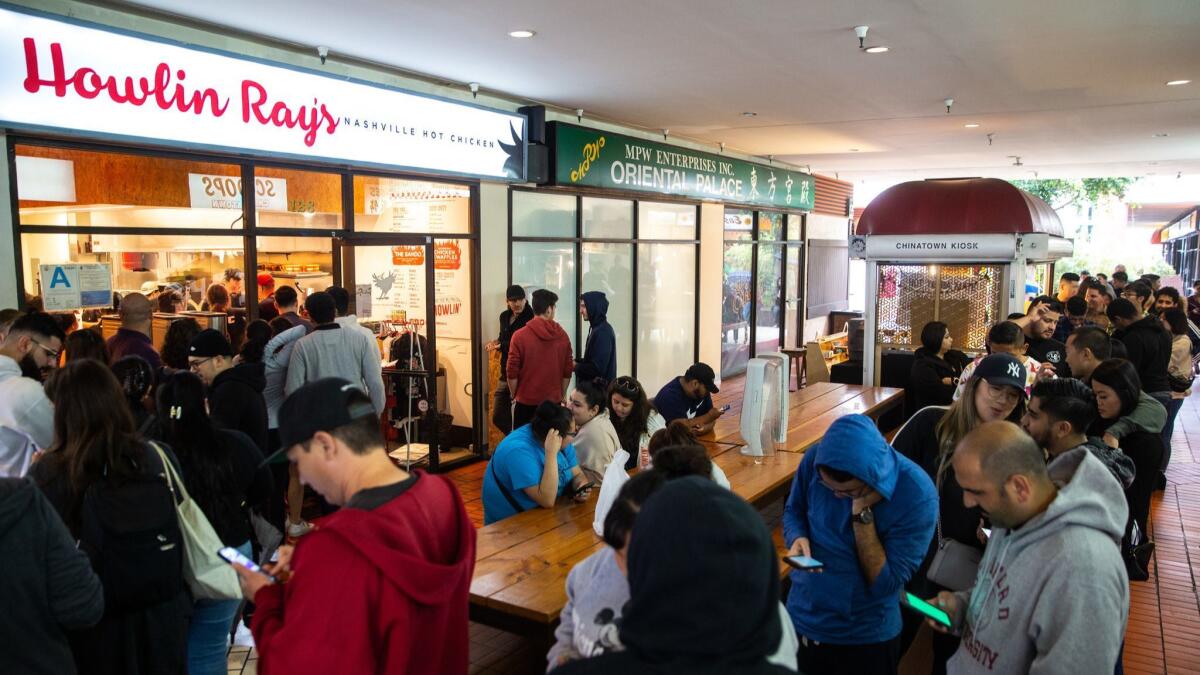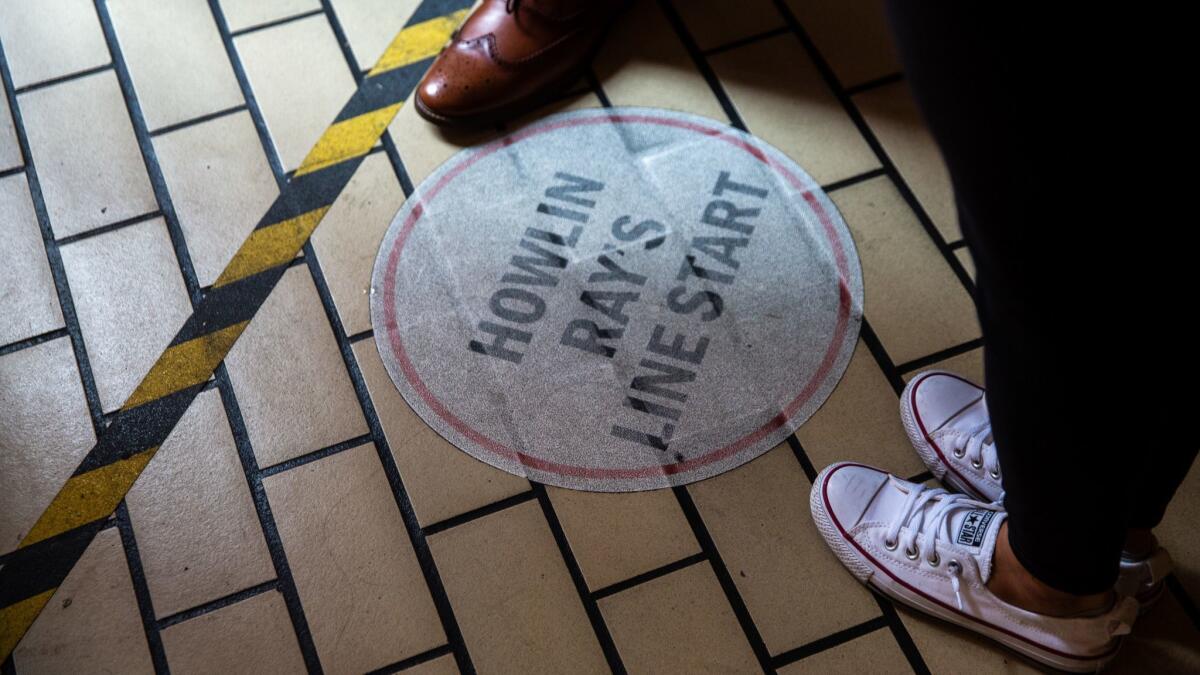Column: Many in Chinatown have never tried its most popular restaurant, so I brought the food to them

- Share via
It’s only been three years, but the line at Howlin’ Ray’s in Chinatown is already the stuff of legend, a spectacle of stoicism, the world championships of waiting.
The Nashville-style hot chicken shop at Far East Plaza has become an essential pilgrimage for a certain kind of Los Angeles foodie. And Howlin’ Ray’s has come up in a lot of the interviews I’ve done with Chinatown locals since the restaurant opened in 2016, an object of bewilderment for some older residents and envy for business owners struggling to make rent. Most I talked with haven’t tried it.
It’s not that Chinese, Vietnamese and Cambodian immigrants and locals don’t like fried chicken. But seniors don’t always have the strength to stand in line for two to four hours, and wage workers can’t take lunch breaks that long. A lot of people just can’t afford it — the median income is $19,500 and the sandwiches cost $12, which is what a lot of people here on fixed incomes would spend on groceries for a week of dinners.
What does it mean when Chinatown’s most popular restaurant is physically and financially out of reach for so many of its residents? How can we bring investment to neighborhoods that badly need it without placing their poorest people at risk?
I’m sorry that I don’t have the answers to those questions. But I thought that Chinatown’s seniors should at least be able to taste some of the food that is helping to transform their neighborhood. So last Thursday, I decided to get in line and bring them some.
I join the line at 2:30 p.m. with about 100 people in front of me. It’s raining, and I’m already questioning my life decision. I really hate lines.
But the wait, which runs between 45 minutes and five hours depending on the time of day and year, has become a celebrated part of the experience. And longer waits magnify the eventual social media glory that accrues to you after your inevitable Instagram post. There’s an arcade game pushed up against a wall, free samples at a yerba mate stand, and for a brief period, even volunteers who hold your place in line for a fee — though the practice is not allowed.

I make conversation with the people in front of me to pass the time. It’s a noticeably diverse crowd of mostly younger people of every race, with transplants, tourists and locals represented. I ended up asking them various versions of the same question: Why are you doing this? No really, why?
“It’s the hype,” says Alex Nguyen, 19, who came in from Temple City, raising his hands helplessly. “If people say it’s good, I’m not going to knock it until I try it.”
“Peer pressure over the internet,” says Andy Tao, 18, Nguyen’s friend.
“If I want to eat it, I’m going to wait for it,” says Jeannie H., 32, a veteran of the lines at the popular seafood restaurant Boiling Crab.
“We already paid for parking,” says David Cheng, 24, of Huntington Beach.
Cheng, Tao, and Nguyen grew up coming to Chinatown on occasion with their parents for food and shopping. But for various reasons, their parents relocated their weekend trips to various places in L.A.’s suburbs. The last time Nguyen came to Chinatown, he says, was to eat at Howlin’ Ray’s.
The second hour ticks by. I fantasize about sitting down. My back throbs, and my feet hurt. Tao and Nguyen are excitedly discussing new San Gabriel Valley food destinations that I’ve never heard of, and I’m starting to feel very old.
When I reach the front around 4:30 p.m., Johnny Ray Zone, the chef, hears that I’m waiting in line for seniors and locals. He gives me a big box of extra chicken to give out and writes “For the people” on it.
Zone has heard the criticisms that his restaurant has helped gentrify Chinatown and says he responds by trying to be a part of the community in whatever way he can. Sometimes he hooks up Castelar Elementary School students with free wings and helps cater community events.
“We’re a family-owned business, not a huge corporation, and we don’t want Chinatown to change like that either,” says Zone.
The bag is heavy, so I sling it over my shoulder and head down Broadway, feeling like a Santa Claus of the deep fryer.
My first stop is Lien Hoa Deli. Behind the counter, Gang Phan, 77, says he’s been intensely curious about the line, which he’s seen spilling out onto the sidewalk. But he’s too old for the wait and works long hours.
I give him a box of country fried chicken, the non-spicy version, and ask the owner, Nam Tsan, 60, if he eats spicy food.
He scoffs, ignores the question and takes a confident bite from a medium-heat chicken sandwich — the third-spiciest sandwich served at Ray’s. His eyebrows skyrocket. His whole face scrunches up, and he sucks air into his mouth.
“Wow, that’s actually spicy,” he says in Mandarin, with respect. He asks how much it costs, I tell him, and he’s even more impressed. “Wow, lucky them. So easy to make money.”
I drop off a box of extra hot at Won Won Mini Market, where the guy behind the counter is in his 20s and theoretically more capable of tolerating the spice. I distribute country-style chicken to workers winding down a shift at the grocery store on the next block. Then I walk over to Hill Street, where I meet King Cheung, a community activist and member of the Chinatown Community for Equitable Development organization, along with a group of seniors who have been curious about the food at Howlin’ Ray’s.
We squeeze into a tiny communal kitchen in a second-floor apartment shared by multiple seniors, seating ourselves on bendy plastic stools from the swap meet. The seniors have all seen the lines but found the wait unmanageable.
“I have enough trouble with these stairs,” says Pang Yun Fei, 77.
I serve them a box of country-style chicken, which everyone eats with hesitant curiosity. The reactions are mixed.

“We are from Guangdong! We don’t eat spicy food,” lectures Yizhong Huang, 75, who took a wing but didn’t eat it.
“It tastes OK, if you take the skin off,” says Mei Wong, 67, scraping the skin off her wing with a napkin.
“It’s too hot,” Fei says. She was referring not to the spice level of the chicken but the “warm” nature of fried foods as defined by Chinese medicine, which categorizes food into three thermal natures that must be kept in balance.
They begin a somber conversation about the dangers of yeet hay, which Cheung explains to me is a Cantonese term literally translating to “hot air” that describes what happens when you eat too much food with warm natures — namely, fried and spicy food.
With growing embarrassment, I realize that for all my good intentions, what I’ve done is bring a group of health-conscious seniors some pretty unhealthy, spicy food that they can’t afford.
The seniors don’t resent Howlin’ Ray’s, or waiting in lines for chicken — Fei says she’ll wait up to 40 minutes for a fresh butchered whole chicken on Lunar New Year. But their favorite restaurants are struggling to make rent, their housing situations are fragile, and there are fewer and fewer businesses in the neighborhood they can afford to shop at.
And in March, the Los Angeles City Council unanimously approved a 725-unit, entirely market-rate apartment complex, waiving all affordable housing requirements. The city is currently reviewing another proposed project called Elysian Park Lofts that would bring about 920 more units of housing to Chinatown.
I think the fried chicken on Fei’s table is connected to all of that, though it can be hard to see how. For help explaining why, I turned to Paul Ong, a professor at UCLA who studies displacement in ethnic communities.
Howlin’ Ray’s and other businesses reach a specific, moneyed clientele through smartphones and social media. Their popularity becomes an asset to property developers, who build more projects serving that clientele. City leaders take campaign contributions from those developers, then enact zone changes, waive requirements for environmental impact reports and allocate public funds for transit, parks and bike shares. That attracts richer residents, which makes real estate more valuable and rents more expensive.
That process doesn’t just change a neighborhood — it creates a newer, more affluent neighborhood that sits on top of the old one, making it harder for it to exist.
And it all happens because we want to eat good food and get likes on our social media posts; because food writers need readers; because chefs rent the only places they can afford; because property owners and developers want to maximize their investments; because politicians want to spur economic development and get reelected.
It’s a situation where focusing on the innocence or guilt of individual decisions obscures the inequality that the overall system creates. And the end result is often not something that anyone wants.
“The biggest challenge is understanding how we all play a role in a much larger dynamic,” Ong says. “And that dynamic is one where we have to talk about, more broadly, what do we want our cities to look like?”
Change is inevitable in Chinatown, and even some of the seniors say they welcome it. Investment in a neighborhood starved for it is celebrated by many in Chinatown as progress. But the changes leave many people behind. For a lot of older residents of Chinatown, the line at Howlin’ Ray’s reminds them of that.
The last stop on my fried chicken sleigh ride was Jadetime.com, a gift shop on Broadway that sells Chinese lanterns and other traditional goods.
Owner Mary Wang, 68, used to have four stores around Chinatown, but now she’s down to two — the others fell to rising rents and landlord changes. A business owner in Chinatown since 1997, she’s been curious and a bit jealous of the Howlin’ Ray’s line.
She asks me why it gets so much business while Chinese businesses are patronized only by out-of-town tourists. It was a tough question. I ramble about social media and the role of food public relations. I whip out my phone and show her how Burgerlords and the other newer Chinatown places had tens of thousands of followers; explain that other popular Instagram accounts help promote them; pull up the articles that food sites had written about them.
I don’t know how to say algorithm in Mandarin, but she seems to understand. She says she mainly just uses her smartphone to watch Chinese dramas, read Chinese news and talk to her relatives. Anytime she has to get a new app or send an email, she asks her daughters, who have busy careers of their own. She wants to change her business and has always considered herself an innovator, but all of this was overwhelming.
She asked me to help set up an Instagram account. She found the interface complicated, but the next morning, I checked her account and found a new post she managed to put up by herself — a picture of the traditional Chinese dragon puppets she sells.
I don’t know how much good it will do, but I double-tapped it anyway.
More to Read
Sign up for Essential California
The most important California stories and recommendations in your inbox every morning.
You may occasionally receive promotional content from the Los Angeles Times.














